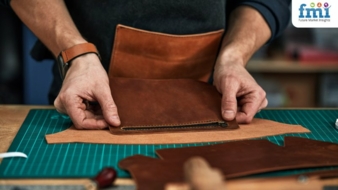09/10/2023 – Future Market Insights
Microfiber synthetic leather market: no animal hides are trendy
The global microfiber synthetic leather market size reached US$ 2,737.3m in 2018. It is estimated to reach US$ 3,203.2m in 2023. Over the assessment period from 2023 to 2033, the global microfiber synthetic leather market is projected to exhibit a 6.1% CAGR. The microfiber synthetic leather market is likely to reach a market size of US$ 5,787.8m by the end of 2033.
Key microfiber synthetic leather highlights
The microfiber synthetic leather market is experiencing significant developments and shifts, particularly in Europe, Asia Pacific. North America, and over the period from 2018 to 2022. In Europe, demand for sustainable leather alternatives is increasing due to environmental awareness and ethical concerns. Microfiber synthetic leather made from bio-based ingredients is emerging as an environmentally friendly solution, especially in the fashion, automotive, and furniture industries. This trend is expected to continue as European consumer choices are said to be influenced by environmental concerns. In the Asia-Pacific region, the fashion industry relies on microfiber synthetic leather for its versatility. It is used for shoes, handbags, clothing, accessories and more because of its flexibility and customization in terms of texture, color and finish. This flexibility allows fashion designers to create unique products that meet the needs of their target customers. North America expresses environmental concerns about the production of microfiber synthetic leather. The use of chemicals like Polyurethane and polyvinyl chloride (PVC) coupled with concerns about disposal and biodegradability, is a source of environmental concern. Addressing these issues is critical to reducing the environmental impact in this region. In contrast to natural leather, which degrades naturally over time, synthetic leather is frequently not biodegradable.
From 2018 to 2022, the market grew at a CAGR of 2.6%, driven by demand for eco-friendly and cruelty-free materials. Technological advancements are expected to further boost demand by improving product quality and texture. The COVID-19 pandemic disrupted the market during this period. The market is projected to grow at a CAGR of 6.1% from 2023 to 2033. Increasing demand for eco-friendly products, especially in fashion and footwear, will be a key growth factor. Microfiber synthetic leather`s adaptability to different textures and styles, durability, and ability to mimic the appearance of genuine leather will maintain its relevance in the market. Overall, microfiber synthetic leather is expected to continue its growth trajectory, addressing environmental concerns while meeting consumer demands for versatile, ethical, and high-quality materials.
Microfiber synthetic leather market trends, opportunities, and challenges latest trends:
- Emphasis on eco-friendliness and sustainablility: there is a growing trend towards eco-friendly materials with lower carbon footprints, driven by both manufacturers and consumers seeking sustainable options.
- Customization and innovation: manufacturers are focusing on creating new properties, color and textures, leading to increased customization and innovation in microfiber synthetic leather products.
- Partnerships with fashion brands: leading companies are collaborating with popular fashion designers and brands to create exclusive and sustainable fashion lines, opening new opportunities in the market.
- R&D in microfiber cleaning cloth: investments in research and developement activities are expected to expand the demand for microfiber cleaning cloth by improving upcycling and recyling options.
Upcoming opportunites orchestrated by countries around the world:
- The U.S. microfiber synthetic leather market is set to witness remarkable growth due to strong demand from various sectors. The focus on sustainability and ethical alternatives is a significant driver. The country is projected to create a total financial potential worth US$ 474.1m by 2033.
- China is said to become a major player in the gobal microfiber synthetic leather market, thanks to its production capabilities, technological advancements, and export potenial. Hence, the market in China is expected to expand at a CAGR of 5.2% during the forecast period.
- The microfiber leather market size in South Korea is set to reach a valuation of US$ 260.7m by 2033. The microfiber synthetic leather market is anticipated to witness a CAGR of 6.4% from 2023 to 2033. Renowned athleisure brands in South Korea, such as Fila, are expected to drive the market by adopting microfiber synethic leather, aligning with the growing demand for ethical and eco-friendly fashion brands.
- Japan is estimated to exhibit a CAGR of 6.6% during the forecast period in the microfiber synthetic leather market. It is likely to top a valuation of around US$ 499.6m by 2033 in the microfiber leather products market.Japanese fashion and apparel brands, like Uniqlo, are likely to use microfiber synthetic leather to cater to the rising demand for eco-friendly fashion choices.
- The United Kingdom is anticipated to expand at a considerable CAGR of 5.3% during the microfiber synthetic leather market assessment period. It is projected to reach a valuation of US$ 187.8m by 2033 in the artificial leather microfiber sector. Celebrity-driven collections are expected to boost the market with stylish faux leather options, attracting fashion-forward consumers.
Challenges:
There are concerns about the long-term performance of synthetic leather compared to genuine leather, which could hamper its growth. The production processes of microfiber synthetic leather can have significant environmental impacts, raising concerns about sustainability. The competitive landscape of the microfiber synthetic leather market is evolving, with opportunities stemming from the apparel and footwear industries. Key players are investing in product development and improving production efficiency. The market is moderately fragmented, with bio-based materials slowly gaining acceptance as their prices decrease. Several companies are innovating in the synthetic leather space, introducing silicone-based vegan leather products, non-carbon-based solutions, and sustainable alternatives to meet evolving consumer preferences and sustainability goals. For example the latest “Compo-SiL” (SL series) silicone vegan leather product was released by General Silicones. It is a Taiwan-based provider of silicone products. The new series is designed for the manufacturers of consumer goods including covers, book bindings, backpacks, belts, shoes, purses, and wallets. It is ideal for those looking for PETA-approved vegan leather supplies with factory-applied fabric lining.




